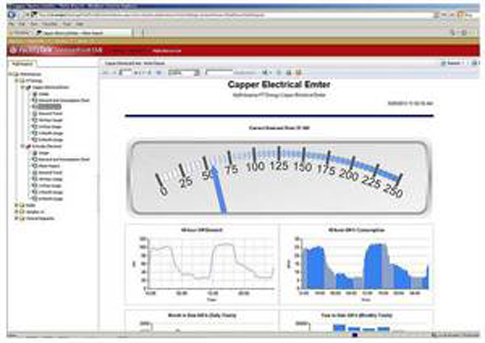Reliance on the wrong metrics to assess value dooms many energy projects to premature death.

The world is facing both an energy and climate crisis, yet the United States wastes 58% of the energy it produces.[i] U.S. companies could save trillions of dollars each year through simple energy efficiency improvements, yet investments in this area remain anemic. Lack of information in both financial and managerial decision making are leading chief financial officers (CFO) to make the wrong decisions when it comes to investing in projects for industrial energy efficiency and sustainability.
There are alternatives to the current prevailing financial and managerial decision making processes for energy efficiency projects that offer a prescription for meeting the needs of both corporate shareholders and the planet.
Energy efficiency by the book
Effectively investing shareholder profits is one of the most critical of all executive functions. This activity drives core business strategy, directly protecting and creating shareholder value. It is therefore no surprise that there has been considerable academic research performed on optimizing corporate capital allocation to achieve maximum shareholder value. A CFO survey published in the Journal of Applied Corporate Finance[ii] found that the majority of companies interviewed applied sophisticated financial analysis techniques, specifically Internal Rate of Return (IRR) and Net Present Value (NPV) calculations in their capital budgeting processes.
This finding may hold the key to why companies are hesitant to make energy efficiency improvements. The adoption of NPV and IRR should ensure that capital budgets are allocated to projects with the highest return. It’s only logical to assume that if there is an apparent under-investment in energy efficiency projects, they must either fail to meet the required rate of return (negative NPV), or there are more projects with positive NPV than available capital. In either case, the CFO who decides not to invest in energy efficiency projects would appear to be operating in the best interests of the shareholder. However, a more in-depth analysis of the data reveals a different possibility.
Energy efficiency investments in the United States could generate at least $1.2 trillion in recovered energy costs, according to findings from a McKinsey study.[iii] What’s more, the risk-return profile of energy efficiency investments shows that they have a rate of return similar to equity investments in small to medium sized firms, but with a risk profile mimicking Treasury bills, according to a 2012 study from ACEEE.[iv] These findings drive toward two conclusions:
- It’s highly unlikely that energy efficiency investments did not have positive NPV or were projected to offer significantly less value than alternative investments. ACEEE found the return on energy efficiency investments to be equal to or greater than the return on equity of the surveyed companies. Therefore, these investments must have IRRs at least equal to the required rate of return, hence a positive NPV. If the NPV was substantially below alternative investments, then by definition, executing those alternative investments would have raised the firm’s return on equity above that found by ACEEE.
- The discount rate applied to determine energy efficiency NPV is inaccurate in this case. The risk of energy efficiency investments is similar to that of Treasury bills. Therefore, the market risk adjusted discount rate applied in the NPV analysis should be consistent with the investment’s risk profile. According to the Journal of Applied Corporate Finance study, companies use a single corporate cost of capital when performing capital budget allocations. This assumes all corporate investments share the same risk profile. Generally, this is a valid and logical assumption, and corporate investment NPV calculations should not depend on the capital financing structure for a specific investment. However, energy efficiency investments are unique—they do not share the same risk profile of the firm because savings generally are not correlated with corporate strategy during the return period. In addition, the investment amount is small and unlikely to result in a meaningful change in the debt-to-equity ratio.
These findings suggest that the apparent under-investment in energy efficiency improvements must be a result of limited available capital. However, it’s difficult to support this conclusion in light of the empirical evidence. Corporate cash balances are at an all-time high, equity prices are near a peak, and interest rates are at the lowest in several decades. Capital is certainly available, but investment is lagging. Therefore, it appears it’s not the availability of capital but rather reluctance on the part of management that is constraining investment in energy efficiency projects.
Since returns on energy efficiency investments are likely to have a positive NPV, it’s possible that a bias exists against these investments, which we should be able to infer based on their percentage of all projects rejected. Anecdotally, companies have several times more investments with positive NPV than are selected. This suggests CFOs are not managing capital investments according to classical allocation theory and are instead rationing investments according to some other criteria.
This all begs the question: Are energy efficiency investments being selectively disregarded? Because the number of rejected investments is so large and poorly documented, it’s impossible to determine with statistical confidence whether energy efficiency investments are subjected to increased bias. However, it is clear that investment selection in capital budgeting is strongly influenced by processes outside of traditional financial theory.
Capital budgeting in the real world
Detailed NPV and IRR analysis requires a considerable investment in time and human resources, and most firms have adopted shortcuts to improve the efficiency of the capital budgeting process. Typically, management develops an initial capital projects list with a focus on strategic investments. These investment opportunities are afforded the complete NPV-IRR analysis process. After the first review and project filtering process, management then takes a bottoms-up approach, allocating a portion of the budget for project ideas from across the organization.
Because the capital budget available for these bottom-up investments comprises a minority of the capital budget, the probability of one of them being selected is low—considerably less than one in seven. As a result, it’s not economically efficient to perform a detailed NPV-IRR analysis for each project. Financial management typically institutes a simple and easy investment opportunity filtering mechanism to quickly assess projects and ensure that the best investment opportunities are identified. The most popular of these filtering mechanisms is simple payback.
Payback, while not as sophisticated as discounted cash flow analysis, does have merit and can be applied with some precision. The difference between discounted cash flow techniques and simple payback converge as the discount rate approaches zero. To apply simple payback accurately, the firm should fix the cost of capital and then calculate the cut-off hurdle rate in years. In general, companies typically use a 24-month payback, regardless of the investment category or true cost of capital. A 24-month simple payback period equates to a 61% discount rate or cost of capital—a number that certainly will filter out all but the most rapid payback investments.
The impact of capital budgeting on energy efficiency investing
Most energy efficiency project requests tend to originate at the plant or operating level, and are therefore subject to the much tighter simple payback hurdle. As a result, very few energy efficiency projects are funded. The lack of energy efficiency investing, along with its associated financial implications, has been researched thoroughly and well documented by organizations such as ACEEE. Unfortunately, the recommendations to remedy the problem typically come in the form of additional government financial incentives, education, and appeals to altruistic behavior. These remedies have consistently failed because they do not address the root cause of the issue: the primary impediment to energy efficiency investment is the use of an inappropriate cost of capital, through the application of the simple payback filter process.
Many corporations have public energy efficiency and sustainability goals and have invested in large, high-profile projects, such as solar farms and windmills. While these projects are both notable and good for the planet, they may not be in the best financial interests of the shareholder in comparison to smaller, less risky energy efficiency investments. Often these high-profile projects are added to the capital budget project list at the executive level during the initial strategic creation of the budget primarily for public relations purposes. While these projects are likely to have passed the required NPV and IRR analysis, they reduce the amount of capital available for higher returning energy efficiency projects—the same projects that often fall victim to the simple payback hurdle rate. Further, the idea that the more visible, high-profile projects may have greater public relations value is not relevant to the shareholder’s financial analysis.
Some prescriptions for success
The evidence clearly suggests that CFOs should review their capital budgeting allocation processes as they relate to energy efficiency investments. A few simple strategies can help make this process more successful:
1. Update simple payback hurdles. Consider calculating the payback-period hurdle using the same discount rate the company applies in its more formal NPV approach. Very few projects—especially those addressing energy efficiency—can meet the high standard required by the 24-month simple payback period. Too many good projects are being prematurely eliminated as a result. In addition, energy efficiency projects often address key operational issues, and when they’re eliminated too early, information that could drive innovation and competitive advantage fails to reach executive management.
2. Use risk-adjusted discount rates. Consider applying different discount rates for different asset classes. For most companies, the risk profile of energy efficiency investments is considerably lower than that of the enterprise, whose consolidated required rate of return is used in the calculation of the NPV. Viewing company investments as a portfolio with different risk-return profiles allows the firm’s cost of capital to represent the market risk adjusted rate on the portfolio. Because the majority of firms use the Capital Asset Pricing Model (CAPM) as the basis for the determination of their cost of capital, this model can be applied to individual proposed projects. The firm can then maximize shareholder return (NPV) given the constraints of total capital available and the consolidated firm’s CAPM determined cost of capital.
3. Off-balance-sheet indirect investing. Energy efficiency investments represent an interesting cost of capital arbitrage. The value of these projects to the firm is lower because of the firm’s higher required cost of capital as compared to how the market would value the investment. Arbitrage intermediaries, such as Energy Service Companies (ESCO), will often make the energy efficiency investment directly, at no cost to the firm. The ESCO earns its return from the generated shared savings. While the firm does not receive all of the savings, the project’s ROI is dramatically improved because the required investment is dramatically reduced (no upfront capital required). There is an altruistic benefit since less energy is wasted and less carbon dioxide and other greenhouse gases are emitted, but for the purposes of this discussion, those are side benefits.
4. Talk to your banker. With interest rates at historic lows, many institutions are looking for low-risk investments with better returns. Energy efficiency investments can fill this need, and many banks have created innovative structures that can meet the varied needs of the corporation, the bank, and corporate shareholders. These energy efficiency projects can often be financed at rates below the firm’s normal borrowing costs.
5. Be informed. Energy efficiency is a key component to combating climate change and helping secure our energy future, and it is also a great investment for shareholders. There are a number of excellent nonprofit organizations that provide valuable information and assistance. These three are a good place to start:
b. WADE (World Alliance for Decentralized Energy) www.localpower.org
c. NREL (National Renewable Energy Laboratory) www.nrel.gov
Conclusion: Less waste, more savings
The United States wastes 58% of the energy it produces. We can do much better but have failed to make the necessary investments that ultimately would benefit corporate shareholders, the nation’s future energy security, and the environment. The challenge is neither technological nor financial. It simply requires reevaluating the processes by which we value energy investments. We owe it to our shareholders to reconsider these processes and review and revise capital allocation practices.
– David March is a Process Capital Productivity Specialist with Rockwell Automation.
[i] Battaglia, Sarah. (2013, March 2). US Now Leads in Energy Waste. The Energy Collective. Retrieved from https://theenergycollective.com/sbattaglia/193441/us-most-energy-waste
[ii] "How do CFOs make capital budgeting and capital structure decisions?," with John Graham, Journal of Applied Corporate Finance 15, 1, (2002): 8-23.
[iii] Energy efficiency: A compelling global resource. McKinsey Sustainability & Resource Productivity (2010).
[iv] The Long-Term Energy Efficiency Potential: What the Evidence Suggests. American Council for an Energy-Efficient Economy, E121, (2012): 8.
This article is part of the April 2013 CFE Media supplement, Industrial Energy Management. See other articles linked below.



